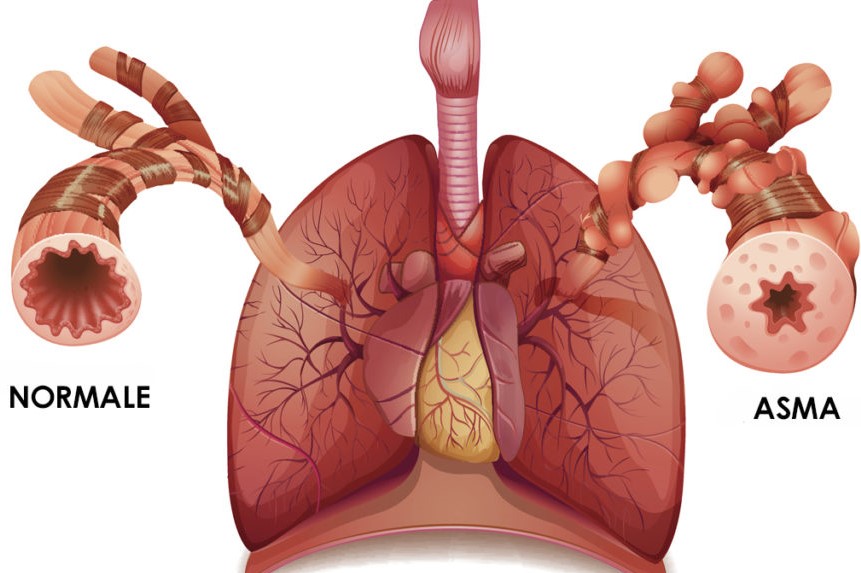
Bronchial asthma: symptoms and treatment
Bronchial asthma is one of the most frequent chronic inflammatory diseases of the bronchi. Several blood cells play an important role in this disease, including mast cells, eosinophils and T lymphocytes
Bronchial asthma may develop for the first time during adult life (late-onset asthma)
It may persist from childhood or recur after a period of remission.
In the Western world, 10-15% of children and 5-10% of adults suffer from asthma.
In 30-50% of children, symptomatic asthma disappears during adolescence, but a certain percentage may reappear in adult life.
Even in individuals who become asymptomatic, lung function abnormalities and bronchial hypereactivity may persist.
In adolesciency, the individuals at risk are mainly males, but in adulthood the situation is reversed.
Severe, or in some way life-threatening, asthma mainly affects women almost twice as often as men.
In several countries there was an increase in asthma mortality around the 1960s.
Since that period, despite the increase in the proportion of patients, mortality rates have remained unchanged, although, in general, the proportion of asthma sufferers in the population has been increasing, with a doubling of cases in recent years.
Signs and symptoms of bronchial asthma
In predisposed individuals, the inflammation causes recurrent episodes of wheezing, choking, chest tightness and coughing, especially at night and in the early morning hours.
Causes of asthma
Asthma symptoms are generally associated with diffuse but variable airway obstruction, which is at least partly reversible spontaneously or after therapy.
Inflammation causes increased airway reactivity to multiple non-specific stimuli (cold air, physical exertion, etc.).
In many individuals this inflammation is caused by an allergic reaction to respiratory antigens (house dust mites, pollen, moulds).
CHILD HEALTH: LEARN MORE ABOUT MEDICHILD BY VISITING THE BOOTH AT EMERGENCY EXPO
Risk factors
Genetic factors are important in triggering asthma.
The exact mode of inheritance is not known but appears to be related to several factors.
A history of asthma and allergy in the parents is the most reliable indication of this familial predisposition.
Environmental factors that may influence the development of asthma include allergens (especially inhalants), viral infections, pollutants and cigarette smoke.
The effect of these environmental factors may be greatest during the first few months of life.
Many asthmatic children are predisposed to be allergic and allergens, viral infections and exercise are the main stimuli for their symptoms.
Diagnosis and Treatment of Bronchial Asthma
The diagnosis of bronchial asthma is based on clinical examination, monitoring of peak expiratory flow (PEF), spirometry and bronchial provocation tests.
Treatment is based on corticosteroids combined with inhaled ß2 agonists, chromones, antileukotrienes and, if necessary in the case of allergic sensitisation, specific hyposensitisation therapy.
Read Also:
Emergency Live Even More…Live: Download The New Free App Of Your Newspaper For IOS And Android
Bronchitis: Symptoms And Treatment
Bronchiolitis: Symptoms, Diagnosis, Treatment
Chest Pain In Children: How To Assess It, What Causes It
Bronchoscopy: Ambu Set New Standards For Single-Use Endoscope
What Is Chronic Obstructive Pulmonary Disease (COPD)?
Respiratory Syncytial Virus (RSV): How We Protect Our Children
Respiratory Syncytial Virus (RSV), 5 Tips For Parents
Infants’ Syncytial Virus, Italian Paediatricians: ‘Gone With Covid, But It Will Come Back’
Respiratory Syncytial Virus: A Potential Role For Ibuprofen In Older Adults’ Immunity To RSV
Neonatal Respiratory Distress: Factors To Take Into Account
Stress And Distress During Pregnancy: How To Protect Both Mother And Child
Respiratory Distress: What Are The Signs Of Respiratory Distress In Newborns?
Respiratory Distress Syndrome (ARDS): Therapy, Mechanical Ventilation, Monitoring
Bronchiolitis: Symptoms, Diagnosis, Treatment
Chest Pain In Children: How To Assess It, What Causes It
Bronchoscopy: Ambu Set New Standards For Single-Use Endoscope
Bronchiolitis In Paediatric Age: The Respiratory Syncytial Virus (VRS)
Bronchiolitis In Infants: Symptoms


